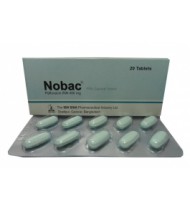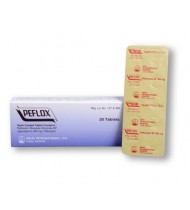Pefloxacin Mesylate Dihydrate
Indications
Pefloxacin is indicated in adult for the treatment of single infection or mixed infections caused by two or more susceptible microorganisms. It can also be used for infections caused by organisms resistant to other antibiotics. Pefloxacin is indicated to the following manifestations:
- Gastrointestinal infection: Enteric fever, acute bacterial diarrhoea & chronic Salmonella carriers.
- Urinary tract infection: Cystitis, pyelonephritis, prostatitis, epididymitis, uncomplicated and complicated urethritis.
- Respiratory tract infection: Pneumonia, acute and chronic bronchitis, cystic fibrosis, bronchiectasis, empyema.
- Ear, nose and throat infection: Otitis media, otitis externa, sinusitis, tonsillitis.
- Bone and joint infection: Osteomyelitis, arthritis.
- Skin and soft tissue infection: Infected ulcer, wound infection, abscess, cellulitis, erysipelas and infected burn.
- Pelvic infection: Salpingitis, endometritis, pelviperitonitis.
- Abdominal and hepatobiliary infection: Peritonitis, intra abdominal abscess and cholingitis, cholecystitis and empyema of the gall bladder.
- Also used in septicemia, bacteraemia, gonorrhoea, endocarditis, meningitis.
Pharmacology
Pefloxcin is a synthetic antibacterial agent, belongs to fluoroquinolone group. It exerts its action by inhibiting the subunit-A of DNA gyrase (Topoisomerase II). Pefloxcin is bactericidal and has a broad spectrum of activity.
Dosage & Administration
Adult with normal hepatic function: Pefloxcin 400 mg tablet 12 hourly (morning & evening) with meals to avoid gastrointestinal disturbances. An initial loading dose of 800 mg may be given in order to produce effective blood concentration more rapidly.
Adult with hepatic insufficiency: In patients with severe hepatic insufficiency or reduced blood supply to the liver, the daily doses should be readjusted by increasing the intervals between doses. Dosage need not to be reduced in renal insufficiency.
Duration of Treatment:
Adult with hepatic insufficiency: In patients with severe hepatic insufficiency or reduced blood supply to the liver, the daily doses should be readjusted by increasing the intervals between doses. Dosage need not to be reduced in renal insufficiency.
Duration of Treatment:
- Usually 5 to 10 days.
- For chronic prostatitis, cystic fibrosis & chronic Salmonella carriers: 14 days.
- For endocarditis: Up to 6 months.
- For chronic osteomyelitis: Up to 1 year.
- For gonorrhoea: 2 tablets single dose.
Interaction
When taken concomitantly with an Antacid containing Aluminium and/or Magnesium Hydroxide gel, absorption of Pefloxacin is reduced. So, concurrent administration of these agents with Pefloxacin should be avoided.
Contraindications
Pefloxacin is contraindicated in patients with known hypersensitivity to Quinolone, children under 15 years of age, pregnant and lactating mothers, patient with inborn glucose-6-phosphate dehydrogenase deficiency and patients with history of tendon lesion, tendonitis or tendon rupture.
Side Effects
Occasionally observed reactions are - Gastrointestinal disturbance: Epigastric pain, nausea, vomiting, diarrhoea, dyspepsia. Central nervous system disturbance: Headache, insomnia. Hypersensitivity reaction: Skin rash, pruritis, photosensitization. Others: Myalgia and/or arthralgia, tendonitis, rupture of achilles tendon.
Pregnancy & Lactation
Pefloxacin has been assigned to pregnancy category C by the FDA.
Precautions & Warnings
Because of the risk of photosensitivity reaction, exposure to sunlight and ultraviolet radiation should be avoided during Pefloxacin therapy. Dosage readjustment is required in severe hepatic insufficiency. Patients should be informed of the possibility of pain in the achilles tendon.
Therapeutic Class
4-Quinolone preparations
Storage Conditions
Keep below 30°C temperature, away from light & moisture. Keep out of the reach of children.
Nobac Tablet 400 mg
IndicationsPefloxacin is indicated in adult for the treatment of single infection or mixed infection..
12.00Tk.
Peflox Tablet 400 mg
IndicationsPefloxacin is indicated in adult for the treatment of single infection or mixed infection..
11.05Tk.
Showing 1 to 2 of 2 (1 Pages)


